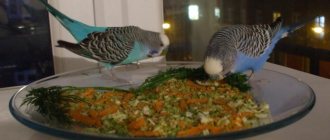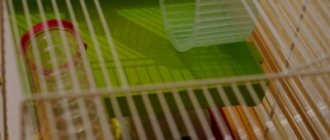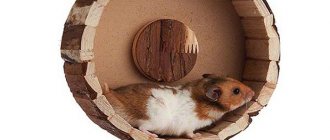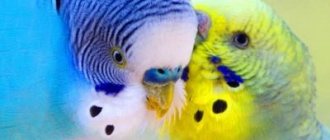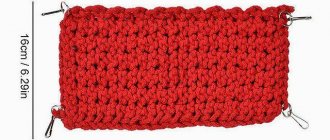What does a rodent eat in nature?
Being an omnivore, the hamster eats almost everything that comes into contact with it. The exact diet is determined by the habitat. If a rodent lives in a steppe or semi-desert, it feeds on protein foods, including:
- Insects.
- Snails.
- Zhukov.
- Worms.
The importance of protein feed increases after hibernation or during gestation.
Field and garden individuals eat greens, fruits, cereals and vegetables. Feeding domestic pets should completely replicate the diet of their wild counterparts.
The natural instinct of hamsters is to be thrifty. Therefore, closer to the winter season, they fill up their storage.
In this case, the pantry must be located in a hidden place and inaccessible to other animals. When keeping a rodent at home, you will need to periodically remove supplies, since food quickly spoils and emits an unpleasant odor.
What should they be?
The main requirement for crafts is safety for the rodent. Be sure to inspect the finished product for sharp parts and other elements that could harm your pet. The use of toxic materials is strictly prohibited. These include varnishes, paints and other similar compounds. When assembling some structures, you may need glue. Make a choice in favor of high-quality compounds that can be used indoors, as well as in homes with small children and animals.
If you decide to make a ladder, labyrinth or other similar structure, accurately calculate its size and shape. The animal should be comfortable while playing.
Rules for feeding at home
In the wild, the daily menu of hamsters is determined by their habitat. To ensure that your pet does not experience a shortage of essential food in captivity, you need to carefully think through the diet and maintain a balanced level of macro- and microelements in the animal’s body.
Mode
Veterinarians recommend feeding your hamster 2 times a day - morning and evening. It is better to give fresh food first so that the rodent does not start hiding it in the pantry. The bulk of the food is served in the evening. Hamsters are crepuscular rodents that prefer a nocturnal lifestyle.
To prevent your pet from overeating or experiencing food shortages, you need to adhere to the established feeding regimen.
Quantity
Depending on the age and size of the pet, different amounts of food are required. The hamster consumes quite a lot of food, and the daily norm is 80-100% of body weight. Appetite is determined by breed characteristics, microclimate and individual preferences of the individual.
The hamster considers food not only as part of the daily menu, but also as a strategic reserve. Therefore, uneaten food is put aside by the rodent in case of starvation. This leads to the appearance of an unpleasant odor and the development of pathogenic organisms in spoiled products. To prevent such troubles, you should remove the remains in a timely manner. Instead, you can put a few seeds in your pet's storage.
What to treat the dzhungarik
You should select treats for dzhungarikas, guided not only by the taste preferences of the rodent. It is not recommended to give dwarfs to eat sweets.
Treat your pet to insects (for example, dried grasshoppers or worms), branches of fruit trees. Be sure to read the list of permitted trees and feeding rules.
The recipes for homemade treats described above are suitable for feeding small Djungarian hamsters. Note that bananas should be given once every 7 days.
Features of special food for hamsters
Ready-made food for rodents is available in pet stores, which have a balanced composition of vitamins and microelements.
Dry
Feeding domestic hamsters should include dry mixtures, which make up the bulk of their diet. Such food is produced using special technologies, taking into account the preferences and needs of the animal. Carefully selected ingredients of natural origin are added to the complexes.
Dry food mixture is the main element in a hamster's diet.
You can also find dry food for sale for other rodents or birds. However, it is not recommended to use them for hamsters, because... they have the wrong composition.
Wet
Despite the use of dry mixtures, natural wet food should not be removed from the hamsters' diet. The following vegetables are allowed to be used for feeding:
- Zucchini.
- Carrot.
- Lettuce leaves.
- Pumpkin, etc.
However, it is better to avoid using watermelons, cabbage, and potatoes, because... they can lead to digestive disorders in hamsters.
It is allowed to add some fruits to the menu. Apples, grapes and currants are especially beneficial for rodents.
Animals like raisins and dried apricots. You can give your pet apricots, pears or bananas as a treat. However, the fruits of the citrus family are contraindicated for hamsters. You should also not feed kiwis and avocados to rodents.
The hamster's diet includes dried apricots and raisins.
Varieties
All toys that are chosen for pet rodents are aimed at two tasks:
- search for treats;
- encouragement to move and be active.
In some products, these two purposes can be successfully combined. It is worth noting that the treat for the hamster is safely hidden. To get to a tasty treat, you need to go through a maze or cope with a tricky structure. The smell of food is an additional incentive to go through the maze or perform other actions.
Other products that do not hide food are considered exercise equipment. The most common toy of this type is the running wheel.
List of recommended foods
Hamsters have a weak stomach, so you can feed them only those foods that they can chew and digest. It is forbidden to give the animal food from the table, spices, hot and sour foods.
Vegetables
You need to include fresh vegetables in your hamster's daily menu. It is necessary even when using ready-made feed. The following products are allowed:
- Zucchini.
- Cucumbers.
- Tomatoes.
- Beet.
- Broccoli.
- Eggplant.
- Bell pepper.
At the same time, you cannot feed the rodent potatoes, white cabbage and canned vegetables.
Fruits
There are several rules to consider when choosing fruit for hamsters:
- Animals are allowed only seasonal fruits grown nearby.
- The fruits must be ripe, but not rotten.
- You can use sour fruits.
- The frequency of taking fruits should not exceed 1-2 times a week.
- It is better to avoid using exotic fruits.
In addition, you should not feed hamsters fruits with seeds.
It is forbidden to give hamsters fruits containing seeds.
Berries
Pets are given fresh and frozen berries. Among them:
- Strawberry.
- Strawberries.
- Gooseberry.
- Cherry.
- Cherries.
- Blueberry.
- Currant.
If the berries contain large seeds, they must be removed before serving to the hamster. The seeds contain hydrocyanic acid, which can negatively affect the health of animals.
Greenery
For greens, pets are given nettles, clover leaves and plantain. If you have a garden area, you can pick lettuce leaves or dill. In winter, many hamster owners germinate cereal grains in the apartment and give sprouts to rodents.
Cereals
Various cereals are beneficial for hamsters. Among them:
- Oats.
- Buckwheat.
- Wheat.
Your hamster's diet should include whole grain cereals.
The main thing is that food for rodents is fresh and natural.
Nuts
Nuts contain a lot of fat. Therefore, they are given to the hamster in limited quantities and rarely (2-3 pieces per day). The pet can be periodically fed hazelnuts, peanuts, walnuts and pine nuts. In addition, he is allowed sunflower, melon and pumpkin seeds.
Dried fruits
Dried fruits are used as treats for hamsters. Allowed products include raisins, prunes and dried apricots.
Milk
Rodents are allowed dairy products. The main thing is that they have a low fat content.
Protein food
In their natural habitat, hamsters eat beetles, insects, worms and snails as protein food. At home, they can be replaced by boiled chicken, eggs, lean fish, mealworms and shrimp.
Pasta and bakery products
Hamsters love boiled pasta. However, they are given as a treat, no more than once a week. Occasionally you can feed your pet stale bread.
Rodents are allowed to give boiled pasta.
Vitamin complexes
Another important component of a hamster’s complete diet is vitamins. He consumes most of the vitamins with food, but additional support for the hamster’s body will not be superfluous to diseases.
In winter, if there is a lack of green vegetables in the diet, it is useful to give the hamster sprouted grains (oats, wheat). This will replenish the animal’s body with vitamins.
The most common way is to buy special vitamin complexes in veterinary pharmacies. When buying vitamins of this kind, you should pay attention to their release form. Tablets and powders are considered a convenient form.
Vitamins in the form of granules or rice balls are used as prophylaxis and do not have medicinal properties.
In addition to vitamin complexes, hamsters need to be fed with minerals. Meat and bone meal is added to the feed as a mineral supplement, but not more than twice a week. When serving, meat and bone meal is mixed with porridge at the rate of 1–3% (young or adult) of the amount of porridge.
Additives to the basic diet include table salt. It is useful in small quantities - in a dosage of 0.02 g for young and 0.05 g for adult hamsters per day.
Apples in the diet of hamsters
Rodents eat apples with particular pleasure. However, such fruits can be given to them strictly according to the instructions. You cannot limit your diet to an apple diet, since the fruits are used as an additional source of vitamins.
Benefits for the body
The key advantage of apples is the high concentration of microelements in their composition. However, one must also take into account the presence of malic acid, which is unsafe for the animal’s gastrointestinal tract.
The fruits saturate the pet’s body with glucose in an acceptable amount.
Apples contain fiber, which improves the digestive system and prevents tumors in rodents.
Variety selection criteria
When choosing a variety of apples, you need to take into account that some hamsters prefer sour fruits, others prefer sweet ones.
At the same time, it is not recommended to give apples with a high concentration of sugars to young animals. This is associated with a risk of developing diabetes. Excessively sour fruits are unsafe for the gastrointestinal tract. Therefore, it is better to find a middle ground using sweet and sour fruits. It is recommended to choose apples grown in the region where the owner lives.
When selecting fruits, you need to make sure that they meet a number of criteria:
- Reached ripeness.
- Grown in a local garden.
- Rinse thoroughly under running water.
It is recommended to give hamsters apples of sweet and sour varieties.
Processing Tips
Before serving to your pet, the fruit must be immersed in water for several hours. If a sweet and sour variety contains a lot of sugar, it can become dangerous for the rodent, especially for its gastrointestinal tract.
The seeds must be removed to avoid poisoning. It is better to remove the peel if the apples were purchased at the store. It is enough to wash the fruits grown in your garden.
Introducing fruits into the diet
You need to introduce apples to your hamsters' menu gradually, sticking to small portions. At the same time, it is important to carefully monitor the general well-being of rodents. If their body reacts positively to the new product, the daily intake can be increased. However, the fruits should not be allowed to rot in the cage area. It is better to give apples to the animal up to 3 times a week.
Various goodies
Grocery stores offer a variety of treats for hamsters. But before purchasing such food, you should make sure that there is no salt, sugar, flavor enhancers or flavorings in their composition. Such additives are a slow poison for rodents. Therefore, it is better to give preference to the following foods:
- Nuts.
- Banana chips.
- Dried fruits and dried vegetables.
- Sunflower seeds.
Sunflower seeds are a treat for your pet hamster.
General recommendations
When choosing a treat for a small pet, you should consider several rules:
- Sugar and honey are contraindicated for hamsters;
- Do not give nuts and crackers containing salt and flavoring additives;
- When choosing a treat in a store, always study the composition, giving preference to natural, without additives;
- prepare a treat from familiar foods;
- When offering a treat for the first time, give a small portion to test the body’s reaction;
- dessert should not replace a meal; if you offer a treat too often, your pet will get used to it and will no longer be so happy when receiving a reward.
It is very important to remember to remove any remaining spoilage food from the feeder and pantry. After three days, the apple given to the hamster will no longer be a dessert and can cause digestive problems.
Source
Tree branches and grass
Solid food is a must for a furry pet. A rodent's teeth continue to grow throughout its life, so when it eats tree shoots, it wears down its fangs.
Before submitting, the branches need to be properly prepared. Raw materials are collected away from roads, for example in the forest or in the country. Then it is thoroughly washed and scalded with boiling water to eliminate pathogens.
It is allowed to feed the hamster with branches of pear, maple, birch and apple trees.
Vitamins for pets
Store-bought mixtures for hamsters contain all the necessary vitamins and microelements. However, in some cases it is necessary to introduce them artificially in order to protect pets from the development of infectious or viral diseases.
Vitamins for hamsters are an important component in their diet.
Vitamin complexes with different compositions are available for sale. However, you cannot choose them yourself without first consulting a veterinarian. The specialist will advise the appropriate complementary foods and dosage based on the age and condition of the pet’s body.
Forbidden food
When feeding hamsters at home, you should avoid the following foods:
- Syrov.
- Cabbages.
- Of bread.
- Fruits of exotic origin and citrus fruits.
- Sausage products.
- Sweet food.
It is better to avoid feeding your rodent dandelions. Their stems and foliage contain milky sap, which provokes irritation of the animal’s pouches.
Hot, spicy and fatty foods should not be allowed in the diet.
Some nuances of feeding
You need to care for hamsters strictly according to the recommendations of specialists. When planning a diet, it is necessary to take into account age, current health status and physiological processes such as hibernation or gestation.
Newborn hamsters
In most cases, the female feeds the children on her own if she is provided with the right conditions. Therefore, there is no need to disrupt the natural cycle. If the female runs away, leaving her offspring orphaned, she has to feed them special food. For the first few days after birth, newborn hamsters are given kitten formula. Pets need to be fed every 2 hours using a pipette.
You can feed the offspring of domestic hamsters yourself using kitten formula.
Individuals aged 2 weeks are given infant formula “Gerber” and “Agusha”, cereals without milk and sugar, and also greens grown at home.
3-week-old animals are offered crushed adult food.
Elderly
As a rodent ages, its teeth begin to deteriorate, so it stops eating as before. Against the background of age-related changes, pureed vegetables and chopped feed should be included in the diet. You can give your rodent baby cereals that do not contain milk. And to avoid problems with the gastrointestinal tract, your pet should be periodically fed grain porridge.
Pregnant or nursing
During pregnancy or nursing the offspring, the female needs to be given a lot of protein food. This includes boiled fish, chicken, eggs, shrimp and mealworms.
Sick and weak
If your pet is sick, he will have to be fed using a syringe without a needle. In most cases, warm chamomile is brewed for such rodents. The use of honey or milk is prohibited. If the hamster refuses to eat food, you will have to forcefully give it, otherwise the pet will not recover.

